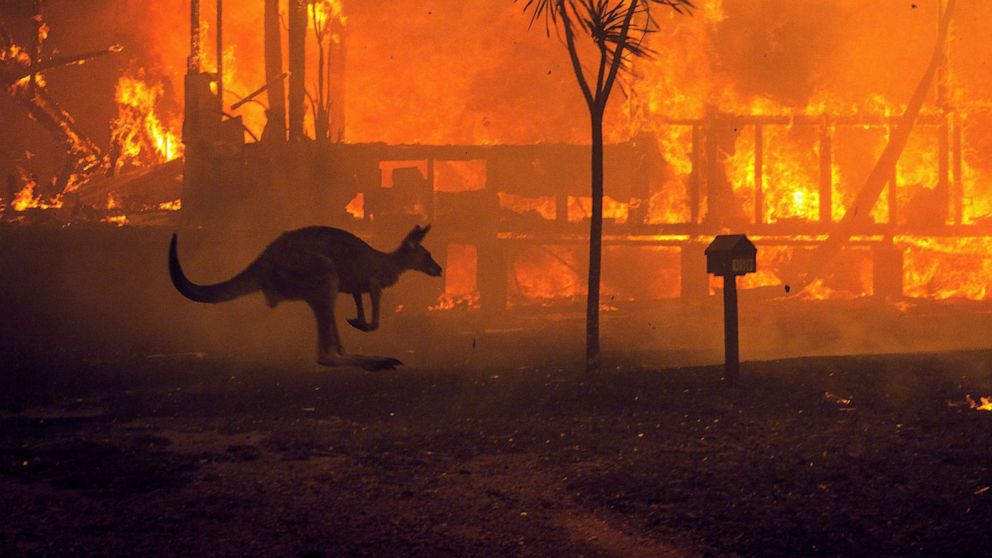Wildlife all over the globe is facing imminent threats due to anthropogenic activities. No species is safe from the wrath of humans, whether it is the gigantic humpback whales, elephants from the animal kingdom, or diverse species of the plant kingdom. Hundreds of species have been removed from the face of the earth, and many more are facing threats to their survival. The speed of the mass extinction of species has accelerated in recent decades due to massive deforestation, mining, and drilling in remote areas, hunting for the precious ivory and many other human activities. The threats of global warming and climate change have further deteriorated the situation not only for humans but also for innocent wildlife. The recent massive Australian bushfires are the manifestation of the threat that life on earth is facing.
The last three years have broken all the previous records of high global average temperatures. While at some places, climate change has caused flash floods, heavy torrential rainfall, storm surges, and tornadoes, in other areas, high temperatures have caused prolonged droughts, shortage of water, and subsequent bushfires.
The vast bushfires in Australia have broken records of all previous bushfires. Millions of hectares of forest have been reduced to ashes in large swathes of the land of kangaroos and koalas. In some places such as at the border of Victoria and New South Wales, three massive fires merged into a mega-blaze. Along with burning millions of hectares of land, the bushfires have killed billions of species. Videos and pictures of Kangaroos, Koalas, and camels, running away from the scorching heat of gigantic fires to seek refuge, have caused emergency calls for the rescue of devastated wildlife.
The devastating wildfires in the iconic continent of Australia have been raging since September 2019, causing unprecedented catastrophe for wildlife. Different estimates of the toll of animals lost have ranged from half a billion to a billion. But experts believe that the death toll of animals lost in bushfires may be much more than these inconceivable figures.

“There is debate about whether half a billion or a billion animals have been affected, but the truth is that by the time we include invertebrates as well as mammals, reptiles, amphibians, and birds, the total will conceivably be in the trillions,” says University of East Anglia biologist Ben Garrod. “With approximately 85 percent of vascular plants and 80 percent of mammals found nowhere else on the planet, the importance of Australia’s endemic flora and fauna cannot be overemphasized, meaning its loss cannot be downplayed.”
The estimates made by experts of World Wildlife to access the loss of species is derived from a methodology based on the impact of clearing land in Australia applied by the University of Sydney professor Chris Dickman. But the estimates made by Dickman’s methodology do not include invertebrates.
Experts also fear that the impacts of the bushfires, which have engulfed over 18 million acres of land, have not become completely visible yet. In the coming months and years, the animals escaping from the scorching heat and fires may have to struggle more for survival due to the loss of habitat and lack of available food resources.
“If we are seeing this level of death, destruction, and loss now, what will our planet look like when global temperatures rise by another two or three degrees Celsius? We need to act as an international community, and if not now, when?”
Kangaroo Island— an island in the south of Australia, 8 miles from the mainland, has been dubbed as “Noah’s Ark on island” due to its diverse population of wildlife, unique ecology and the seclusion it provides to species from disease and predators— has been hit by the apocalyptic bushfires. There are fears that the island might never recover from the massive destruction.

The kangaroo island is one of the most important wildlife sanctuaries in Australia, having national parks for the conservation of wildlife and hiking trails sprawling on the beautiful island. The fires in this island off mainland Australia were shockingly destructive due to the speed and extreme behavior. The landscape in this once beautiful island gives a picture of a trail of destruction. Scorched land, rows upon rows of trees, some still burning from the inside, and smoke fills the landscape. Dozens of charred carcasses of Kangaroos and Koalas depict the horrible destruction of the massive bushfire, which has ravaged vast swathes of territories across Australia.
“It’s apocalyptic,” says Caroline Paterson, a former ranger who was based in Flinders Chase for eight years. The south-western part of the island, which was sanctioned as the wildlife sanctuary by the Australian government, has now been completely destroyed.
An analysis by the federal environment department has found that more than 80% population of almost 50 threatened species have been affected by the bushfires.
The Guardian reported that another 65 species have more than half of their area in the fire zone. Scientists have warned some affected species could be pushed to extinction.
The 49 species which have been affected the most include 47 species of plants, one species of spider, and another 331 migratory species, which are believed to have more than 10% of their habitats in the zones across six states of Australia.
These are not just the figures or statistics but an eye-opener for humans, across the globe, that such vast varieties of species are at the risk of extinction due to human activities. Last year hundreds of scientists also warned that there is a dire need to strengthen laws for conservation of wildlife. Otherwise, our planet is facing the threat of imminent mass extinction.
Also Read: How the Australian wildfires are affecting the Koalas

Muhammad Abdullah Khan has done bachelors in Chemistry from Government College University
Lahore. He is a science enthusiast and loves to read and write about astronomy, cosmology and latest
scientific endeavors.

